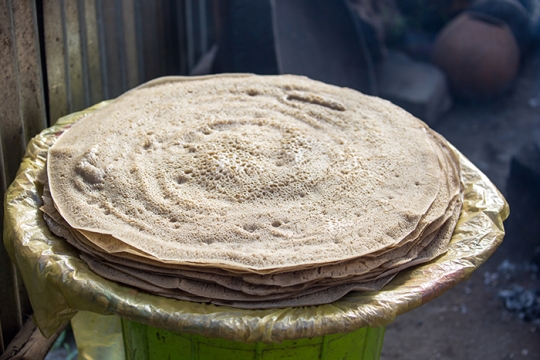When it gets too hot to turn on the oven and you don’t want to spend time kneading, braiding, or rising, try this pan-baked bread from Ethiopia. If it’s too steamy for challah and you still want a yummy, fresh, home-prepared bread for Shabbat, turn to injera for one bowl, two-ingredient, stovetop option.
For Jews who lived in Ethiopia, constraints such as limited fuel sources, hot climates, and unavailability of wheat and local fours that are either low in gluten or lacking glutenous flours resulted in flatbreads.
While the injera served at Ethiopian restaurants is often mixed with wheat, this recipe uses only teff, available at health food stores and online. I enjoy it with gazpacho, fried eggs, marmalade, melted cheese, peanut butter, or as an accompaniment for summer soups and salads. Generally, it’s best to serve it right away, but no worries, it won’t be around long. It can also be frozen layered with parchment paper and then reheated in a pan or a microwave. These Jewish flatbreads of Ethiopian Jews reserve energy for summer fun.
This simple injera ferments naturally over a full day.
1. Mix together the teff flour and the water in a large bowl until a smooth batter forms. Cover the bowl tightly with plastic wrap, with space between the batter and the plastic. It needs air to ferment.
2. Let the batter sit at room temperature until it foams, about 24 hours. Do not disturb the mix to stir in the meantime. Just let it sit.
3. Uncover the batter at the end of the 24 hours. If there is a layer of water on top, pour it off and discard. Don’t pour off any batter. Mix the batter to smooth it like a pancake batter. If it’s very thick add some water.
4. Spread a kitchen towel or parchment paper over the work surface.
5. Heat a 12-inch non-stick pan over high heat. Put small amount of oil in the pan. Quickly ladle ¾ cup of the batter into the pan starting tow swirl from the middle to the outer edge of the pan. Don’t try to fill in the gaps. Adjust the heat so injera does not burn.
6. Cook for about 30 seconds until the injera bubbles on top; then cover with a lid for about two more minutes, until it no longer looks glossy. If condensation forms inside the lid, wipe it down.
7. Drop the injera onto the towel or parchment paper and repeat. The remaining injera can be stacked onto parchment paper.
8. Serve warm or refrigerate stacked on the parchment paper stored in a plastic bag for a day. I also sometimes freeze it. When I want some, I take it directly from the freezer, toast it, or re-warm it in a pan. It gets crunchy, which I like.


